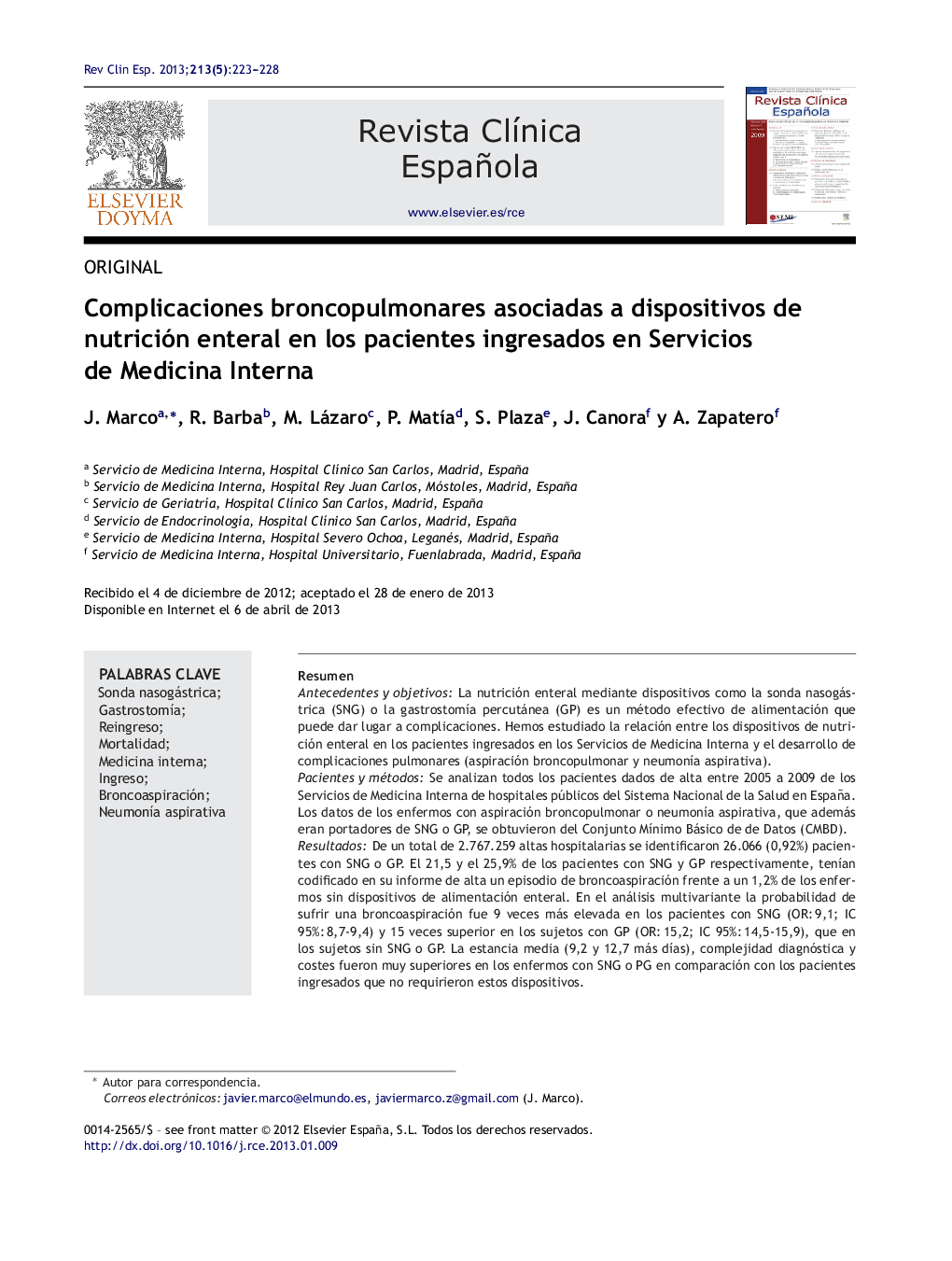| Article ID | Journal | Published Year | Pages | File Type |
|---|---|---|---|---|
| 3827199 | Revista Clínica Española | 2013 | 6 Pages |
ResumenAntecedentes y objetivosLa nutrición enteral mediante dispositivos como la sonda nasogástrica (SNG) o la gastrostomía percutánea (GP) es un método efectivo de alimentación que puede dar lugar a complicaciones. Hemos estudiado la relación entre los dispositivos de nutrición enteral en los pacientes ingresados en los Servicios de Medicina Interna y el desarrollo de complicaciones pulmonares (aspiración broncopulmonar y neumonía aspirativa).Pacientes y métodosSe analizan todos los pacientes dados de alta entre 2005 a 2009 de los Servicios de Medicina Interna de hospitales públicos del Sistema Nacional de la Salud en España. Los datos de los enfermos con aspiración broncopulmonar o neumonía aspirativa, que además eran portadores de SNG o GP, se obtuvieron del Conjunto Mínimo Básico de de Datos (CMBD).ResultadosDe un total de 2.767.259 altas hospitalarias se identificaron 26.066 (0,92%) pacientes con SNG o GP. El 21,5 y el 25,9% de los pacientes con SNG y GP respectivamente, tenían codificado en su informe de alta un episodio de broncoaspiración frente a un 1,2% de los enfermos sin dispositivos de alimentación enteral. En el análisis multivariante la probabilidad de sufrir una broncoaspiración fue 9 veces más elevada en los pacientes con SNG (OR: 9,1; IC 95%: 8,7-9,4) y 15 veces superior en los sujetos con GP (OR: 15,2; IC 95%: 14,5-15,9), que en los sujetos sin SNG o GP. La estancia media (9,2 y 12,7 más días), complejidad diagnóstica y costes fueron muy superiores en los enfermos con SNG o PG en comparación con los pacientes ingresados que no requirieron estos dispositivos.ConclusionesExiste una asociación entre la SNG y la GP para la alimentación enteral y las complicaciones pulmonares. La estancia media, complejidad diagnóstica y coste por ingreso de estos pacientes fueron más elevados que los que no precisaron dispositivos de nutrición enteral.
Background and aimsEnteral nutrition using feeding devices such as nasogastric (NG) tube or percutaneous endoscopic gastrostomy (PEG) is an effective feeding method subject that may give rise to complications. We have studied the relationship between enteral nutrition feeding devices in patients admitted to the Internal Medicine Departments and the development of pulmonary complications (bronchial aspiration and aspiration pneumonia).Patients and methodsAll of the patients discharge between 2005 and 2009 from the Internal Medicine (IM) Departments of the public hospitals of the National Health System in Spain were analyzed. The data of patients with bronchial aspiration or aspiration pneumonia who also were carriers of NG tubes or PEG, were obtained from the Minimum Basic Data Set (MBDS).ResultsFrom a total of 2,767,259 discharges, 26,066 (0.92%) patients with nasogastric tube (NG tube) or percutaneous gastrostomy (PEG) were identified. A total of 21.5% of patients with NG tube and 25.9% of patients with PEG had coding for a bronchopulmonary aspiration on their discharge report versus 1.2% of patients without an enteral feeding tube. In the multivariate analysis, the likelihood of suffering bronchoaspiration was 9 times greater in patients with SNG (OR: 9.1; 95% CI: 8.7-9.4) and 15 greater in subjects with PEG (OR: 15.2; 95% CI: 14.5-15.9) than in subjects without SNG or PEG. Mean stay (9.2 and 12.7 more days), diagnostic complexity and costs were much higher in patients with SNG or PEG compared to patients in hospital who did not require these devices.ConclusionsAn association was found between SNG and PEG for enteral feeding and pulmonary complications. Mean stay, diagnostic complexity and cost per admission of these patients was higher in patients who did not require enteral nutrition.
